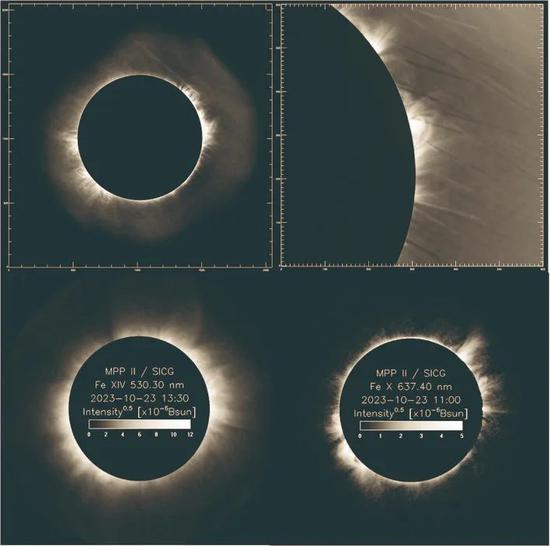
The first coronal images captured by China's Spectral Imaging CoronaGraph were published by the Changchun Institute of Optics, Fine Mechanics and Physics last month, setting a new global standard for precision. (Photo/the Changchun Institute of Optics, Fine Mechanics and Physics)
The first coronal images captured by China's Spectral Imaging CoronaGraph were published by the Changchun Institute of Optics, Fine Mechanics and Physics last month, setting a new global standard for precision.
The achievement marked the successful completion of work on China's first independently developed ground-based coronagraph.
Zhang Hongxin, a researcher at the institute, said the coronagraph, sitting at an altitude of 3,200 meters at the Lijiang Yulong Astronomical Observatory in Yunnan province, had three key components: an optical imaging lens, an optical filter and an equatorial mount.
Zhang's team began researching the optical imaging system in December 2019, setting the groundwork for the coronagraph's successful development and becoming pioneering researchers in the field in China.
Scientific data obtained from the coronagraph has been lauded internationally, with the instrument recognized as the world's foremost ground-based coronagraph thanks to its sub-0.5-nanometer optical glass accuracy.
Jointly developed by Shandong University, the institute in Changchun, the Chinese Academy of Sciences, the Nanjing Institute of Astronomical Optics and Technology, and CAS' Yunnan Observatory, the coronagraph is a testament to China's advances in astronomical instrumentation.
Zhang said observing the sun's corona, the outermost layer of its atmosphere, was important for various scientific purposes. However, capturing the coronal signal, which is significantly weaker than the brightness of the solar sphere, posed a considerable challenge due to atmospheric light scattering.
To address the challenge, Zhang and his team pioneered the precision polishing of optical glass to below 0.5 nanometers to suppress stray light. They simulated an artificial sun in the laboratory and used meticulous calculations, filtering and testing to achieve the desired precision.
Zhang said the project had significantly enhanced the team's scientific research capabilities, marking a new starting point in their field. It now plans to conduct debugging and testing, and optimize the equipment's operation.


















































 京公网安备 11010202009201号
京公网安备 11010202009201号